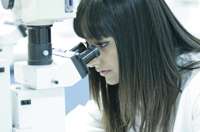Three-in-one 'supermolecule' could detect cancer early, help destroy tumours and monitor treatment

The same protein could potentially be targeted to detect precancerous breast cells; deliver radiotherapy to destroy tumours; and monitor the effectiveness of treatment, according to a Cancer Research UK study presented at the NCRI Cancer Conference in Liverpool today.
Oxford University scientists at the Cancer Research UK/MRC Gray Institute for Radiation Oncology and Biology showed in the laboratory that a technique monitoring high levels of a protein called Gamma H2AX, found in many pre-cancerous cell types including breast, lung and skin cancer, could be used to detect cancer early.
The team took microscopic images of fluorescent 'flag' molecules attached to an antibody which 'homes in' on and attaches to Gamma H2AX, to identify areas of DNA damage*. The fluorescent 'snap shots' of Gamma H2AX revealed the location of pre-cancerous breast cancer cells at a very early stage.
Professor Katherine Vallis, who led the study at the Cancer Research UK/MRC Gray Institute for Radiation Oncology and Biology at Oxford University, said: "This early research reveals that tracking this important molecule could allow us to detect DNA damage throughout the body. If larger studies confirm this, the protein could provide a new route to detect cancer at its very earliest stage – when it is easier to treat successfully."
Previously the team modified an antibody to target Gamma H2AX and deliver radiotherapy to breast cancer cells which contained high levels of the protein. This form of radiotherapy works by boosting DNA damage until cells can no longer repair mistakes – and die.
The results confirmed that the radioactive antibody killed breast cancer cells and slowed tumour growth.
Prof Vallis added: "We need to confirm these findings in larger studies before we know if this approach could benefit patients. But these initial results show that it may be possible to track down cells with high levels of DNA damage, and destroy them before they became cancerous.
"One day we may be able to scan the body to map out the radioactive antibodies that have attached to the Gamma H2AX molecule. This could also allow doctors to paint a useful picture of how effective a treatment is."
Dr Julie Sharp, Cancer Research UK's senior science information manager, said: "This important study reveals that targeting this key molecule could provide an exciting route for new ways to detect cancer at an earlier stage – and help to deliver radiotherapy and monitor its effect on tumours.
"Thousands of cancer patients in the UK, and millions worldwide, benefit from radiotherapy every year. Cancer Research UK has invested heavily in research such as this to explore new ways to improve this vital treatment."
More information: www.ncri.org.uk/ncriconference … /abstracts/B221.html















